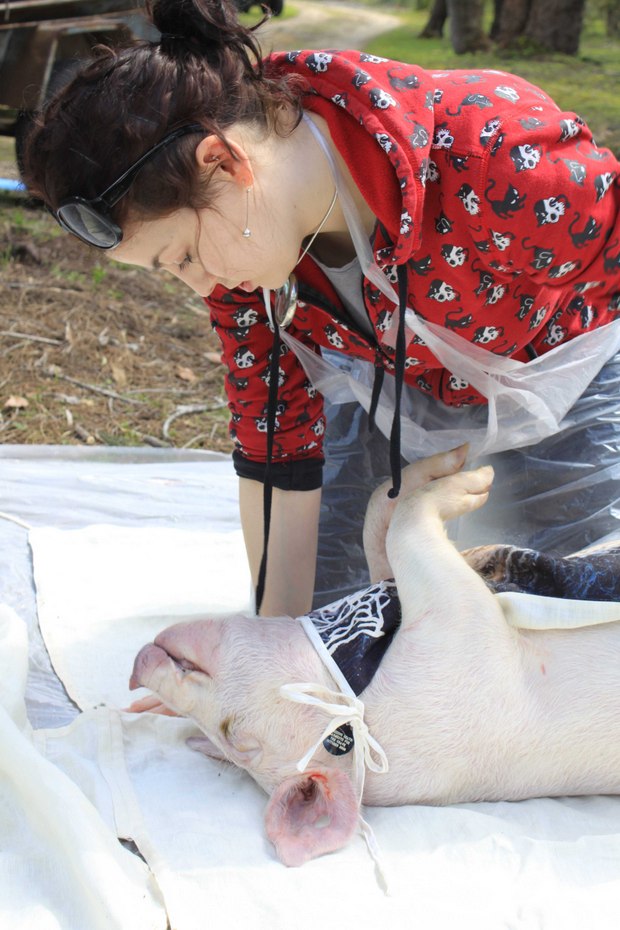
I went to lift one of the pigs out of the garment, I put my hand under its back and was holding a spinal cord…
Pia Interlandi’s doctoral thesis at RMIT University in Melbourne involved studying how long it took for a burial garment she made out of hemp, silk and polyester to decompose. She dressed 21 dead pigs in the garment and dug them up every 50 days for a year. Pigs are the best alternative to human cadavers because their anatomies, skin thickness, and fat deposits are similar to our own. Pia also discusses her dream to open a natural burial ground bed & breakfast in the Australian rainforest. To read the first part of the interview, in which Pia discusses dressing dead relatives and zombie apocalypse fashion, click here.
What’s it like dressing a dead pig?
I’m a vegetarian and freaked out about killing pigs for my work. I contacted the place where we’d be getting the pigs and decided it was okay since they were already going for human consumption. But I asked if we could use the sick ones, unfit for consumption. I ended up naming them, Roach for Mary Roach, Burton, after Tim Burton. The pigs were head-bolted, then seconds later dragged out onto the grass, steam still rising off them. It was horrific, to be honest. They had lots of dirt, crap, blood, and brains on them. I washed all the pigs with shampoo and rosemary oil; they smelled so nice after that. We dressed them and put them in coffins, ascribing to natural burial rules, shallow graves, and no embalming. I wanted to encourage decomposition. What a natural burial is really about is allowing the body to break down and provide nutrients to the site.
Other Great Reads: Everything you need to know about natural burials
What kind of clothes were the pigs buried in?
I designed a three-piece shroud; the first piece was made of hemp, which is cellulosic, and wrapped against the body. The second piece was made of silk, which is more like a protein, and wrapped around that and the third piece was the outer layer and made of polyester, which is synthetic. Each garment was identical. They were all finished around the edge with silk, and there were cords that ran throughout made of polyester. Synthetics like polyester have only been around since the Second World War, we have no idea how they decay and if they decay. I was trying to answer some of those questions.
So you dug up the pigs, then what?
On the first dig, I was anticipating the worst smell ever and maggots and vomiting everywhere, but it just wasn’t like that. When proteins like skin and tissue break down, they release ammonia, so that overwhelmed me. The smell was like a really bad urinal. I wasn’t prepared for that smell, but because we had cleaned the pigs and wrapped them, there wasn’t any time for flies to be laying larvae, and there weren’t maggots. At that point, the garments were saturated in fluid, it wasn’t blood, just fluid from inside the body that had migrated into the cloth, making the cloth heavy.
What were the pig carcasses like in later digs?
In the second dig, 100 days in, everything was like putty. There was nothing holding anything together. I went to lift one of the pigs out of the garment, I put my hand under its back and had a spinal cord in my hand. That was the most disgusting part of the whole experience. It was amazing, the body was just falling apart. You don’t recognize them as being pigs anymore. I felt like I was interrupting this undressing process. Little things were coming in and taking little things away, drinking stuff up. The garments had been saturated and everything was wet and gooey. Later in the year things started to dry up, 150 days in the hemp was just brittle and if you rubbed it between your fingers it turned to dust. The silk and polyester were holding up.
“Picture roots coming out of the skull and curling around the eye socket”
Three hundred days in I started noticing it was harder and harder to dig down to where the pigs were. All these root structures were honing in on the bodies. There is a succulent plant known as pig face, a thick watery cactus like aloe vera and they had grown all over the burial site, we had to dig through all these roots to reach each pig. With water being evaporated away the tissue was becoming just soil. We pulled a pig up and it was just bones and polyester wrapping around it and roots everywhere, they had gone through the skeleton. Picture roots coming out of the skull and curling around the eye socket. It was like a message, this now belongs to the earth. There was this amazing metaphor of the body becoming the landscape, it all sounds lovely and spiritual but this was hard science, too. At the end, if you gave the polyester a rinse you could reuse it. The silk really took about 250 days then it shattered, turned to dust. The hemp had been gone long ago.
Other Great Reads: The futile obsession with coffin’s that allow you to escape
Based on the Pig Project, what type of clothes do you think dead humans should be buried in?
Any cellulosic fiber is good. I mainly use hemp, it grows incredibly quickly, and you don’t need a whole lot of pesticides, unlike cotton, which uses a heap of water and needs quite a lot of care. I use silk but try not to commission new silk, because they basically kill silk worms for their cocoons. I go through vintage stores and get old pieces of silk. I use lots of old kimonos. The embroidery, which was polyester as well, actually lasted almost to the skeleton stage. So if people want a token of permanence they can embroider something, like their family name, that will last as long as the bones. Generally, I subscribe to the philosophy that everything returns to the earth and we should be encouraging the release of the body. The garments are really about the psychological protection of the living, so they are comfy, they look nice, they are luxurious.
Are you now making grave garments for people?
Yes, one of my first clients wanted an undergarment with a beautiful white crane pattern. She was 60 and is not ill, she believes she has entered the third act of life and wants to celebrate it, and be prepared. She has lots of grown children and lots of grandchildren. I created a half hour documentary about the process of working with her that was screened across Australia. People have been responding to that and asking for commissions. The prices vary, I really hate charging anyone anything. I did one for about 85 quid ($125). I should really be charging about 3,000, considering the time that goes into each one. The main emphasis is ease of dressing, so families can dress the body themselves without having to move it around significantly. If you imagine a bed sheet but double the length, cut a hole in the middle and you put the body onto one half and the head through the hole and then just fold the pieces of cloth over the front. You can tie cords around or adorn different things to the neckline, like lace.
What’s your dream project?
Right now the law doesn’t allow for natural burial but I want to open up a natural burial ground in Australia. Death is completely uncontrollable but there are certain familiar things you can choose to make it as easy as possible, like where you want to be buried, the music that will be playing, what you’ll be wearing. It would be a chance to give the process back to the people whom it matters most. There are some beautiful places in Australia, I went to this one bed & breakfast set on a hill, valleys all around. On one side was the rainforest, on the other the ocean, and in a paddock there were cows. I thought that would be perfect for a burial ground. Families could come and stay for the ceremony, then come back years later and have picnics. I would like to re-home some animals, my mom wants a llama. I told her I’d bury her in her own little paddock and she could have a friendly alpaca or llama wandering over her. That’s the pipedream.









